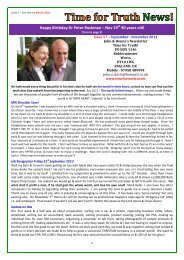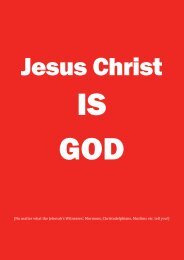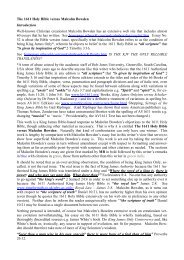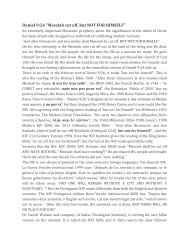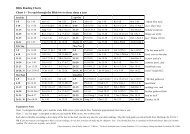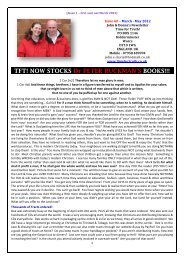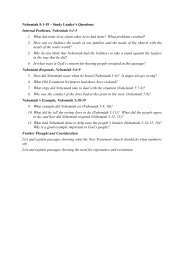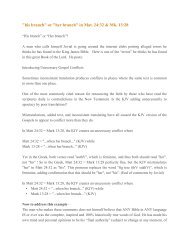A Grievous Wolf - Time for Truth
A Grievous Wolf - Time for Truth
A Grievous Wolf - Time for Truth
You also want an ePaper? Increase the reach of your titles
YUMPU automatically turns print PDFs into web optimized ePapers that Google loves.
33<br />
more feasible to import English language Bibles rather than produce them, but there was also the legal<br />
issue of the fact that the “King James Version” of the Bible was still arguably the “copyright” of the<br />
English Crown, since “public domain” laws were not yet commonplace. Still, demand <strong>for</strong> Bibles was<br />
exceeding supply, particularly since England was keeping an import-export embargo against the rebellious<br />
colonists due to the Revolutionary War. American pride and independence was also on the line.”<br />
Although about 500 Catholic Bibles were printed in the US in 1790, very little demand <strong>for</strong> them existed.<br />
The demand was overwhelmingly <strong>for</strong> the 1611 Holy Bible, as the site shows. It lists the early King<br />
James Bible publishers in the US; Robert Aitken, William Young, Isaac Collins, Isaiah Thomas, Jacob<br />
Berriman and John Thompson, who sought to meet the public demand <strong>for</strong> Bibles in the years of the<br />
English embargo after the Revolutionary War.<br />
“On January 21, 1781, Robert Aitken petitioned the Unites States Congress to authorize, and if possible<br />
even fund, the printing of a complete Bible in the English language of the King James Version. On September<br />
10, 1782, Aitken received authorization from the United States Congress to commence his American<br />
printing of the Bible in English. This is the only instance in history of the U.S. Congress authorizing<br />
the printing of a Bible. In subsequent years, that session was often mockingly referred to as “The<br />
Bible Congress.” Thus, in 1782, Robert Aitken produced the first English language Bible printed in<br />
America. In 1783, George Washington wrote a letter commending Robert Aitken <strong>for</strong> his Bible. The<br />
Robert Aitken Bible is known as the “Bible of the American Revolution” and it remains the most rare<br />
and valuable of early American English Bibles.<br />
“...in 1790, Philadelphia printer William Young produced a press-run of likely not more than a few<br />
hundred copies of a very small coat-pocket sized King James Version Bible. This was the first American<br />
Bible to be printed together with a Psalter. It was marketed as a “school edition” <strong>for</strong> students.<br />
William Young’s Bible is also unspeakably rare today.<br />
“In 1789, Collins announced his proposal to publish the entire Bible (KJV) if he could obtain a 25%<br />
deposit from at least 3,000 subscribers. By 1791, he had produced 5,000 copies of the first Bible printed<br />
in New Jersey. Due to its fairly large size and clear type, unlike all the small coat-pocket American<br />
Bibles and New Testaments that had come be<strong>for</strong>e it, the 1791 Isaac Collins Bible became known as the<br />
first “Family Bible” printed in America...The 1791 Isaac Collins Bible served as the standard of excellence<br />
and the prototype <strong>for</strong> many American Bibles <strong>for</strong> the next 110 years. Though 5,000 copies were<br />
originally printed, fewer than 100 are known to exist today.<br />
“Isaiah Thomas was one of the most successful printers in Colonial America. He published a newspaper<br />
called “The Massachusetts Spy” in which he supported the cause of the colonists. During the Revolutionary<br />
War, Thomas moved his presses to Worcester, Massachusetts. There, in 1791, Isaiah Thomas<br />
published the first illustrated Bibles printed in America. (Many historians believe that his production<br />
was completed just days after Isaac Collins completed his Bibles that same year). Thomas produced his<br />
1791 Bibles (KJV) in two <strong>for</strong>ms: a large folio of two volumes, and a smaller but still quite large, royal<br />
quarto of one volume.<br />
“In 1796, Jacob Berriman of Philadelphia published what may be called the first “single volume illustrated<br />
tall folio” (KJV) Bible printed in America. Long prized by collectors of Colonial American Bibles,<br />
this printing features excellent examples of the work done by several American engravers of the<br />
1700’s. It is a work of exceptional beauty.<br />
“In November of 1798, John Thompson, also of Philadelphia, produced the first Bible ever to be “hotpressed”<br />
in America (KJV). This printing technique helped to sear the ink clearly into the paper with<br />
heat. It was a huge pulpit folio, printed in two volumes…the largest Bible printed in America up until<br />
that time. The Thompson Hot-Press Bible remains an extremely rare collectors’ item.”<br />
Melvyn Bragg in The Book of Books pp 53-54, 142 says of the Pilgrim Fathers that “It is likely that<br />
most of them took the Geneva Bible...[but] the King James Version took over...The Geneva Bible was<br />
the Bible first taken to America, and...it soon became supplanted by the King James Version.”<br />
Gordon Campbell in Bible p 152 states that when the import-export embargo was eventually lifted,<br />
“Thereafter KJVs imported from England dominated the market” such that American Bible publishers




